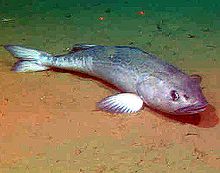Sablefish
| Sablefish | |
|---|---|
 |
|
| Anoplopoma fimbria | |
 |
|
| Scientific classification | |
| Kingdom: | Animalia |
| Phylum: | Chordata |
| Class: | Actinopterygii |
| Order: | Scorpaeniformes |
| Family: | Anoplopomatidae |
| Genus: |
Anoplopoma Ayres, 1859 |
| Species: | A. fimbria |
| Binomial name | |
|
Anoplopoma fimbria (Pallas, 1814) |
|
The sablefish (Anoplopoma fimbria) is one of two members of the fish family Anoplopomatidae and the only species in the Anoplopoma genus. In English, common names for it include sable (USA), butterfish (USA),black cod (USA, UK, Canada), blue cod (UK), bluefish (UK), candlefish (UK), coal cod (UK), coalfish (Canada), beshow, and skil(fish) (Canada), although many of these names also refer to other, unrelated, species. In the USA, the FDA accepts only "sablefish" as the Acceptable Market Name; "black cod" is considered a vernacular (regional) name and should not be used as a Statement of Identity for this species. The sablefish is found in muddy sea beds in the North Pacific at depths of 300 to 2,700 m (980 to 8,860 ft) and is commercially important to Japan.
The sablefish is a species of deep sea fish common to the North Pacific ocean. Adult sablefish are opportunistic feeders, preying on fish (including Alaskan pollock, eulachon, capelin, herring, sandlance, and Pacific cod), squid, euphausiids, and jellyfish. Sablefish are long-lived, with a maximum recorded age of 94 years.
The white flesh of the sablefish is soft-textured and mildly flavored. It is considered a delicacy in many countries. When cooked, its flaky texture is similar to Patagonian toothfish (Chilean sea bass). The meat has a high fat content and can be prepared in many ways, including grilling, smoking, or frying, or served as sushi. Sablefish flesh is high in long-chain omega 3 fatty acids, EPA and DHA. It contains about as much as wild salmon.
...
Wikipedia
